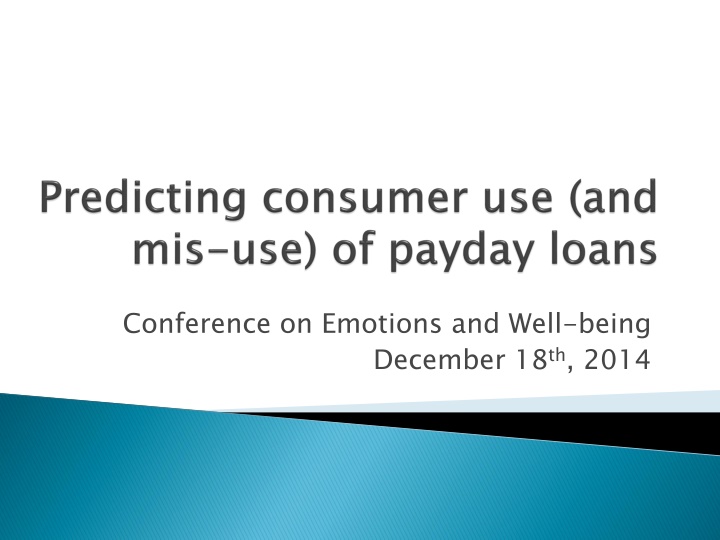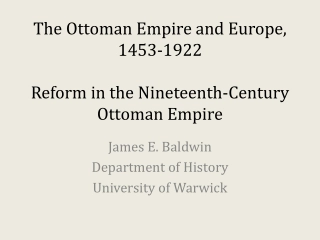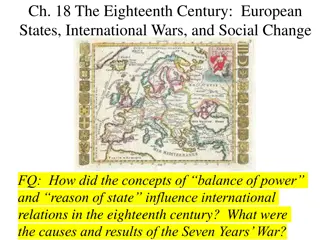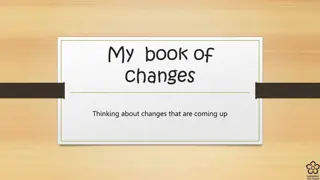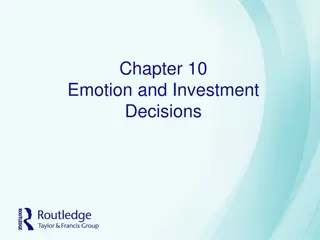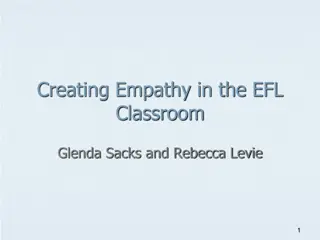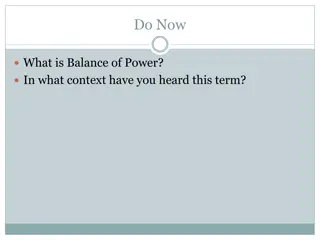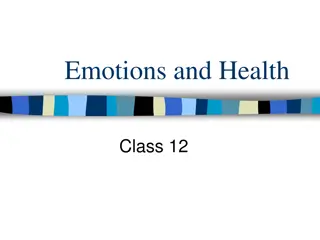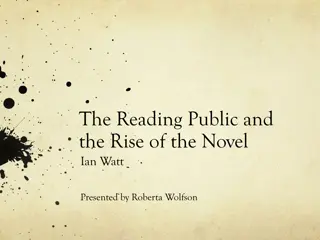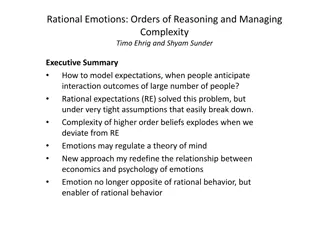Conference on Emotions and Well-being December 18th, 2014
This conference on emotions and well-being held on December 18th, 2014, featured discussions on financial struggles, payday loans, and expense prediction bias. Stories of individuals experiencing challenges were highlighted, emphasizing the need for understanding and addressing these issues in society.
Download Presentation

Please find below an Image/Link to download the presentation.
The content on the website is provided AS IS for your information and personal use only. It may not be sold, licensed, or shared on other websites without obtaining consent from the author.If you encounter any issues during the download, it is possible that the publisher has removed the file from their server.
You are allowed to download the files provided on this website for personal or commercial use, subject to the condition that they are used lawfully. All files are the property of their respective owners.
The content on the website is provided AS IS for your information and personal use only. It may not be sold, licensed, or shared on other websites without obtaining consent from the author.
E N D
Presentation Transcript
Conference on Emotions and Well-being December 18th, 2014
Co Franklin Shaddy, Chuck Howard RAs: Funding: Co- -authors: authors: Abigail Sussman, Melissa Knoll, RAs: Sammie Chan, Mary Ho Funding: SSHRC Insight Development Grant
Sandra Harris Student in Head Start, later served on the board Employee of the Year at UNC-Wilmington Radio personality on WMNX Husband lost his job Could not afford the car insurance bill 1 This story was featured in a report from the Center for Responsible Lending
Cash from a payday loan for $250 She paid her insurance bill Two weeks later, she was ready to repay the loan, plus the $50 fee You know, you can renew, the payday clerk told her, and the thought of her unpaid electricity bill flashed into her head. Sandra thought, You re right. I do need it.
Next month was no easier She kept rolling over the loans and even the fees Eventually, the lender required full repayment She went to another payday lender and took out a loan to pay back the first lender Within six months, she was paying rollover fees on six different loans Basically, we ended up having to use one loan to pay off another loan, and ended up paying $495 to $600 per month in fees, never paying the loans down
H1: future expenses. H2: occurrence of future expenses, rather than the amount of each expense. H3: problematic use of payday loans (and other high-interest loans). H1: Consumers generally under-predict H2: This is driven by under-predicting the H3: This expense prediction bias may lead to
Payday loan primer Payday loan lit Expense prediction lit Study 1: Exploring payday loans (qualitative) Study 2: Prediction bias study Study 3: PD loan prediction study Study 4: Prediction bias refinement study Summary Discussion questions
A payday loanwhich might also be called a "cash advance" or "check loan" is a short loan, generally for $500 or less, that is typically due on your next payday ~20% fee , due one repayment of the loan Most people paid bi-weekly Annualized interest rate: over 500% There are more payday loan shops (23K) in the U.S. than McDonald s (12k) and Starbucks (9k) combined. $3.5 billion in fees every year in the U.S. Three-quarters of all payday loan volume comes from rollovers a short- -term term loan, generally for $500 or less, that is typically due on your next payday.
Pawn shop loans Late fees & reconnect fees Overdraft charges Loan sharks
Fast, convenient cash No access to other credit (e.g., credit cards) Cheaper than some alternatives (lost job, bounced check, cancelled utilities, loan sharks)
Some studies find harmful effects from payday lending (Campbell, Mart nez-Jerez, & Tufano, 2012; Carrell & Zinman, 2008; Carrell & Zinman, 2014; Melzer & Morgan, 2009; Melzer, 2011; Morgan, Strain, & Seblani, 2012; Skiba & Tobacman, 2009; Weaver & Galperin, 2014) Others find beneficial effects (Karlan & Zinman, 2010; Lawrence & Elliehausen, 2008; Morgan, 2007; Morgan & Strain, 2007; Morse, 2011; Zinman 2010) Perhaps single use is beneficial, but rollover use is harmful? So, why might rollovers happen?
The Budget Fallacy: people (mainly students) under-predict future expenses (Peetz and Buehler 2009; 2013) Especially strong for those with a savings goal Eliminated when focusing on competing goals Eliminated when considering an event (rather than a time period) Perhaps this bias leads to payday loan rollovers
My car broke down and I needed finances to fix it. I needed to pay for health insurance before the deadline. Needed to pay rent. Well, it's not the best reason at all but I wanted money to go to the casino.
What circumstances led you to take out the payday loan? What circumstances led you to take out the payday loan? Car Rent 23% 26% Medical Food or groceries 15% Debt (including credit card and other bills) 21% Other 11% 4%
I managed to borrow the money from a friend. I got a loan from my brother I waited to buy groceries and spent that alotted money on bills I just ate ramen and didn't really do anything else.
Do you have family and friends to whom you feel you can go for financial help? Do you have family and friends to whom you feel you can go for financial help? 43% Yes No 57%
Do you have any ways to earn extra money, if needed? Do you have any ways to earn extra money, if needed? 28% Yes No 72%
Under prediction of future (relative to past) expenses Particularly among PD loan users Two part study, 1 week apart MTurk (N=194 part 1; N=140 part 2)
Approximately how much did you spend on optional expenses in the past week $___ dollars Approximately how much did you spend on required expenses in the past week $___ dollars Approximately how much do you anticipate spending on optional expenses in the next week $___ dollars Approximately how much do you anticipate spending on required expenses in the next week $___ dollars in the past week? in the past week? in the next week? in the next week?
Only 10% of sample used PD loans, but trend for greater bias among PD loan users No income prediction bias
Consumers under-predict future expenses Particularly required expenses
Expense prediction bias -> problematic payday loan use Particularly true forunexpected expenses How to define problematic use? Rollover use Wouldn t use again Wouldn t recommend to a friend
MTurk (N = 200). 100 PD loan users, 100 non- users Screener questions: gender, age, PD loan Recall and predict expenses (and income) Detailed questions about PD loans and other debt Also measured other individual differences: Propensity to plan - Money - Short Run (Lynch et al 2010) Discounting (Kirby 1997 subset) Risk pref for gains & losses Numeracy Demographics, including available resources
Imagine that you have to pay an unexpected bill immediately. For example, suppose that you use your vehicle for work, and you need to make an expensive repair that is not covered by insurance. Considering all possible resources available to you (including savings, borrowing, etc.), what is the maximum dollar amount that you could come up with on short notice? $___
Payday loan use (N=200) .11 .00 Payday loan use (N=200) Payday loan rollover (N=100) .24* .08 .23* -.15 Payday loan rollover (N=100) Required Expenses Prediction Bias Optional Expenses Prediction Bias Unexpected Expenses Prediction Bias Financial Resources Available for an Emergency Household Income Education Propensity to Plan (short term) Consideration of Future Consequences Discounting of Gains Risk Seeking for Gains Risk Seeking for Losses Numeracy Required Expenses Prediction Bias Optional Expenses Prediction Bias Unexpected Expenses Prediction Bias .05 Financial Resources Available for an Emergency Household Income Education Propensity to Plan (short term) Consideration of Future Consequences Discounting of Gains Risk Seeking for Gains Risk Seeking for Losses Numeracy -.31** -.1 -.24** .15* -.10 .17 -.09 -.26** -.21* .21** .05 .03 -.13 -.05 .08 -.15 .03
Use payday loan again (N=100) Use payday loan again (N=100) Recommend payday loan to friend (N=100) -.07 -.05 -.12 -.04 Recommend payday loan to friend (N=100) Required Expenses Prediction Bias Optional Expenses Prediction Bias Unexpected Expenses Prediction Bias Financial Resources Available for an Emergency Household Income Education Propensity to Plan (short term) Consideration of Future Consequences Discounting of Gains Risk Seeking for Gains Risk Seeking for Losses Numeracy Required Expenses Prediction Bias Optional Expenses Prediction Bias Unexpected Expenses Prediction Bias Financial Resources Available for an Emergency Household Income Education Propensity to Plan (short term) Consideration of Future Consequences -.05 Discounting of Gains Risk Seeking for Gains Risk Seeking for Losses Numeracy .07 -.01 -.06 -.21* .00 -.15 .02 .11 -.10 .06 -.07 .02 -.03 .00 -.14 -.05 -.02 -.04 -.02
Required expenses prediction bias is correlated with: pawnshop loan use, .15* number of pawnshop loans, .15* car loan debt, .16* Not much there on income
Consumers under-predict future required expenses, replicating Study 2. This bias is especially pronounced among payday loan rollover users.
Simple vs categorical expense estimates Simple version: Expenses last week and next week Category version (2x2): Required vs Optional X Expected vs Unexpected Lots of definitions Hypothesis: unexpected required expense bias best predicts PD loan rollovers (false!) MTurk (N=405; n=200 PD, n=200 non-PD) Unique expense listing
What did you spend money on last week that you won t next week? What will you spend money on next week that you didn t last week? Measures: average number of expenses average value of expenses Predictions: Great number of unique expenses in future (than past) Equal value of future vs past expenses
Predictor Predictor Payday status (1 N=405 .12 Payday loan status (1- -3), N=405 loan 3), Payday loan user, Payday loan user, N=405 Rollover user, n=203 Rollover user, n=203 N=405 Simple expense bias Categorical expense bias Propensity to Plan Consideration of future consequences Available financial resources Income Education .11 .08 -.12 -.13 -.03 .08 .11* -.07 -.11* -.09 -.08 -.27** -.27** -.09 -.04 -.16** -.05 -.16** .00 -.06
Study 3 run in several batches, during the evening east-coast time (late afternoon pacific) Study 4 run in one quick batch, during the morning and mid-day east coast time Possible participant misrepresentation of PD- loan status? (Forums, etc.) PD loan condition filled up before control condition!
Consumers under-predict future expenses Driven by required expenses, more than optional expenses A difference in the number of future expenses rather than the amount of future expenses Unique to expenses there is no bias for income This bias may be especially pronounced among problematic payday loan users Better with a simple question than a detailed breakdown
What sample sources do you recommend (other than MTurk), for studying PD loans? How can we de-bias consumers in their expense predictions? How do we define a good or bad use of payday loan? And how do we define a good or better decision? What are your standards for study reporting? What do you do with failed studies, conditions, or replications? How do you set targets for data collection? What do you require as a reviewer? Best way to improve this social dilemma?
John Oliver: https://www.youtube.com/watch?v=PDylgzyb WAw
